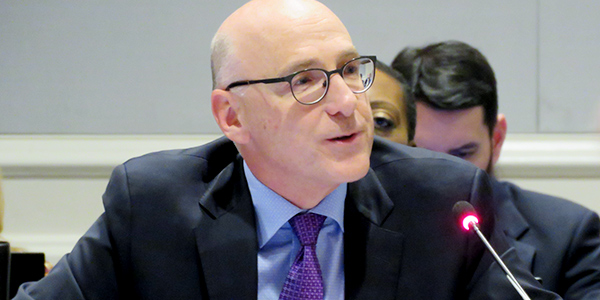By Rich Heidorn Jr.
ATLANTA — NERC’s briefing on its revised ERO Enterprise Long-Term Strategy last week prompted a discussion on whether it is feasible to apply cost-benefit analyses to reliability standards.
In their comments on the strategy plan, both the National Rural Electric Cooperative Association and the Electricity Consumers Resource Council urged NERC to incorporate a cost-benefit analysis before adopting future standards.
“We’ve been struggling with that issue for a while,” Hydro-Québec’s Sylvain Clermont said during the discussion at the Members Representative Committee’s quarterly meeting. “It’s like an oasis in the desert. We know there is an oasis in the desert. We even think we heard someone who saw the oasis. But nobody can quite find the oasis.”
“This is a really tricky area,” NERC Board of Trustees Chair Roy Thilly said. “Every survey we have done points out that stakeholder concern that cost really be considered in the standard [development] process.”
But doing a formal cost-benefit analysis before implementing a standard is difficult, Thilly said. “The effect on one entity may be very different than the effect on another entity, given where they already are in dealing with the issue.”
Industry can help NERC determine the least-cost way to accomplish the goal of a standard, he said. And an after-the-fact review once there is experience with a standard may be possible. “There may be much better information” then, he said.
Cost Effectiveness More Realistic?
Clermont agreed that cost effectiveness may be a more realistic goal.
“If there are two ways to implement a standard, which is more effective than the other one? That’s perhaps an easier question than is there a [positive] cost-benefit or is there a business case to develop a standard,” he said. “I would say that there is most likely never a business case to develop a standard.”
NERC CEO Jim Robb said the ERO is aware of the industry’s challenge in funding improvements for security and resilience “against the backdrop of flat to no load growth in many jurisdictions.”
“Everyone, when they cast a vote for a standard or against a standard, is making their own assessment as to whether or not it’s worth the [cost]. I don’t think we ever want to get to the point where we have a big econometric department at NERC … but I think we want to make sure we are reaching out and getting input from industry so the work we do is economically informed, even though that’s on the fringes of our mandate.”
State/Municipal Utility sector representative Carol Chinn of the Florida Municipal Power Agency said it would be helpful to “have compliance in the room when standards are developed.”
“I think there’s a lot of unknowns when standards are approved about how can you comply with it. These things are complex. When you look at, for example, CIP-003 … it’s [effective] Jan. 1. What are the expectations for compliance? What do we need to do?”
The strategy document was revised following comments from six industry groups, which also included the Edison Electric Institute and the ISO/RTO Council. It is set to be brought to an endorsement vote at the board’s Dec. 12 conference call after input from regional entities.
‘Focus Areas’
The new plan is based on four “Enterprise Value Drivers”:
- Organizing and deploying top talent.
- Developing and delivering innovative and risk-based programs and tools.
- Collaborating effectively with industry and other stakeholders.
- Maintaining independence and objectivity.
It identifies five “strategic focus areas”:
- Expand risk-based focus in all standards, compliance monitoring and enforcement programs.
- Capture effectiveness, efficiency and continuous improvement opportunities.
- Assess and catalyze steps to mitigate known and emerging risks to reliability and security.
- Build a strong, Electricity Information Sharing and Analysis Center-based security capability.
- Strengthen engagement and collaboration across the reliability and security ecosystem in North America.
“We recognize that the electric system as it is today isn’t our grandfather’s electric system. … Lots of changes [are] coming at us in a lot of different directions,” Robb said. “So we always need to be thinking about … whether the programs we execute — many of which were designed 10 to 12 years ago — are still the right programs.”
The goal, he said, is “keeping eyes on the big issues [and] not getting distracted by the trivial.”
“Many of the things that we do have their roots in not only reliability and security but also … the resilience of the system, so you’ll see more references to resilience in the new document” than the 2017 strategy document it will replace, Robb said.
Funding
Andy Dodge, director of FERC’s Office of Electric Reliability, asked about the new plan’s reference to investigating “funding mechanisms” to support NERC’s mission.
Robb said that was a “placeholder” for potential programs that could be structured like the Cybersecurity Risk Information Sharing Program, which is funded by industry and the Department of Energy rather than the Federal Power Act Section 215 assessments that fund the ERO’s operations.
“A number of important issues that get identified in our various assessments … end up with a recommendation that says someone should do X and someone should do Y. And in many of those cases, we don’t really have any ability for establishing accountability as to who’s actually [going to] get it done,” Robb said.
“For example: new planning models … that would be necessary to address variability of resources on the system. … That’s not something we have the expertise to do in-house ourselves, but it’s something that’s very important to be developed,” Robb continued. “Maybe four or five entities would like to push that forward.
“That’s kind of the notion. It’s really not much more developed than that.”






